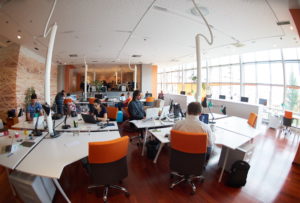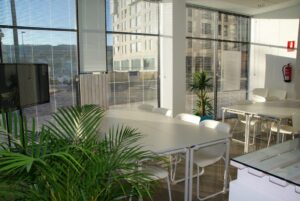Are offices getting bigger or smaller, and why?
Let’s start with the conclusion: The honest answer is that both stories are true. Some organizations are taking up more and larger offices, others are compressing. What ties the two together is a single idea that now sits at the heart of Facilities Management: rightsizing. Size follows purpose. If the purpose is clearer collaboration, better energy performance, and a stronger talent offer, then the footprint, big or small, needs to follow those requirements.
What does the research say?
From our Crown Workspace 2025 survey, a few market signals stand out. Most respondents say they work in the office full-time, yet fewer prefer that model, and almost half would be encouraged by better on-site technology.
Facilities leaders expect to design more interactive spaces in the next three years, and about half also expect to downsize, often to support collaboration and sustainability goals. In other words, the direction is mixed, the intention is not. Offices are being reshaped to work better for people, cost and (increasingly) sustainability. We’re also seeing Outside our own research; the wider market picture paints a similar picture.
CBRE’s 2025 occupier survey reports employers now expect about 3.2 days in the office on average, while actual attendance is close behind at 2.9 days.
Another, related CBRE release states 72 percent of companies are meeting their attendance goals, up from 61 percent last year. Worker attendance is, therefore, increasing, but hybridity is also very much here to stay. Routinely ranking among the top preferences (after salary) for employees from employers.
How are businesses responding?
In two main ways. First and as you’d expect, by trimming excess. JLL (the global real estate firm) highlights a rising preference for flexibility. What this means in practice is to de-risk long commitments (i.e. don’t get locked into a 10-year lease paying for a giant office you don’t need). Second, by trading up. Commercial Real Estate firm, Savills, also observes many occupiers taking less but better quality space. Crucially, they also note a shortage of “good quality offices”. Knight Frank describes this as a “flight to value”, where businesses are prepared to trade floorspace for premium amenities.
But there’s are countercurrents too, as our own research shows. Space requirements are rising in some markets, and a share of companies are planning to expand, especially in buildings that help them compete for talent. A recent Times article reports firms that “downsized after Covid” are now struggling to find the right offices as demand for space outpaces supply. In the U.K., several trackers suggest vacancy is stabilizing or easing in prime locations, with Central London space on the market falling in early 2025 and new build vacancy very tight.
So why is all this taking place?
Why do some footprints grow while others shrink? It comes down to how organisations answer four linked questions: how many people need to be in at the same time, what work they come in to do, what quality of space they need to do it, and how sustainability targets constrain or enable choices. Our own research investigates this in a little more detail. We’ve identified four key drivers:
- Employees still associate the office with productivity and creativity, but they want spaces that feel personal and quiet. Forty five percent say they are more productive in the office than at home, yet only about two thirds feel their workplace really supports wellbeing, and fewer than a quarter call their environment extremely successful for productivity or creativity. Asked what would bring them in more often, almost half chose access to quiet zones and set desks with proper kit.
- Facilities leaders say they will act. Seventy six percent expect to create more interactive environments in the next three years. About half expect to downsize, most often to support open, hybrid friendly designs and to align with sustainability goals. Rightsizing and redesigning usually go together.
- Sustainability is shaping size as well as specification. Nearly three in five respondents say it is already a high or top priority, and almost all organisations report at least one green initiative. Yet employees define a truly sustainable office in more structural terms, like renewable energy and real waste reduction, not only recycling bins and a few plants. This pushes owners and occupiers toward better performing buildings and away from older stock, which can mean less space overall, but of a higher quality, with lower energy use per person.
- Another lever is circularity. Our survey finds the vast majority of facilities managers would consider refurbished furniture, and many already run circular strategies for office equipment. That matters for scale decisions because it makes reconfiguration cheaper and faster. If you can refit a floor with renewed furniture and redeploy stored items, you can test new ratios without committing to permanent buildouts.
Does this mean big HQs are a thing of the past?
Not a chance. None of this means the era of the big HQ is over. If you do that work, you will likely end up with less space than before, but it will be more valuable per square foot. In markets where teams are back more often, or where the talent and brand case for a buzzing central hub is strong, you may take more space, but you will spend more of that budget on quality and adaptability than on raw area.
That is what rightsizing really means. Bigger or smaller is the wrong first question. Better is the right one.
Want to read more about how office spaces are evolving? Download our research piece: “Is it time to kill the open office?” today.
Related stories
Explore actionable strategies to reduce office waste – covering recycling tips, e-waste handling, paper reduction, and sustainable procurement – to help your workplace go greener and smarter.
Uncover insights from 1,000 workers and 200 facilities managers on sustainability, greenwashing, circular economy practices, and how to design offices that deliver real environmental impact.
Crown Workspace Hong Kong has been awarded Silver for Best Workplace Consultancy at the HR Vendors of the Year Awards 2025, recognizing its excellence in delivering innovative, employee-centric workspace solutions across Asia.




























